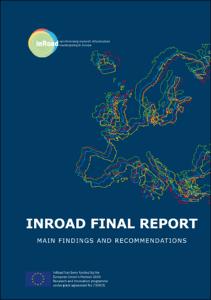| dc.date.accessioned | 2022-07-06T19:39:00Z | |
| dc.date.available | 2022-07-06T19:39:00Z | |
| dc.date.issued | 2018 | |
| dc.identifier.citation | InRoad Project (2018) InRoad Final Report: main findings and recommendations. Bern, Switzerland, Swiss National Science Foundation for InRoad Project, 149pp. DOI: http://dx.doi.org/10.25607/OBP-1782 | en_US |
| dc.identifier.uri | https://repository.oceanbestpractices.org/handle/11329/1983 | |
| dc.identifier.uri | http://dx.doi.org/10.25607/OBP-1782 | |
| dc.description.abstract | Europe benefits from a very rich and diverse Research Infrastructure (RI) landscape. This
landscape is spread over the 28 Member States of the European Union and a series of countries
associated to the European framework programmes for research and innovation. Investigating
this landscape, from the regional to the European level, is a fascinating endeavour. The
diversity of existing practices for deciding which RIs to fund, how to fund them and how to
run them can of course threaten the efficiency and the sustainability of the landscape. After
spending two years in the context of InRoad looking into the details of these practices, I was
surprised how dynamic this environment is, with a constant evolution of practices and models,
but also how little was known or shared about national processes.
Naturally, InRoad has not limited itself to looking and describing national RI funding and decision-
making processes. The project has also put forward a series of recommendations and
good practices to be debated in view of enhancing coordination within the RI landscape in
Europe. It is now up to the broad and diverse community addressed in the following report to
take those practices forward and implement them in the respective contexts.
The initial idea beyond the InRoad project came from a series of activities undertaken by the
Science Europe working group on RIs between 2014 and 2016, summarised in the report
‘Strategic Priorities, Funding and Pan-European Co-operation for Research Infrastructures in
Europe’. Since then, the political landscape has advanced significantly, due to the work done
on the long-term sustainability of RI by the European Commission, the European Strategy
Forum for Research Infrastructures (ESFRI), the OECD and others. All these debates have
been (and still are) taking place while InRoad was conducting surveys, interviews and expert
workshops on the matter. InRoad always has taken an open and proactive stance with respect
to these developments and has offered a platform of exchange and shared its draft insights to
stimulate the debates.
I sincerely hope that the recommendations and good practices listed in this document will
further nurture the debate around RI long-term sustainability and contribute to a more efficient
and integrated European Research Area. | en_US |
| dc.description.sponsorship | European Union | en_US |
| dc.language.iso | en | en_US |
| dc.publisher | Swiss National Science Foundation for InRoad Project, | en_US |
| dc.subject.other | Research infrastructures | en_US |
| dc.subject.other | Business planning | en_US |
| dc.subject.other | Sustainability | en_US |
| dc.title | InRoad Final Report: Main findings and recommendations. | en_US |
| dc.type | Report | en_US |
| dc.description.status | Published | en_US |
| dc.format.pages | 149pp. | en_US |
| dc.contributor.corpauthor | InRoad Project | en_US |
| dc.description.refereed | Refereed | en_US |
| dc.publisher.place | Bern, Switzerland | en_US |
| dc.subject.parameterDiscipline | Cross-discipline | en_US |
| dc.description.currentstatus | Current | en_US |
| dc.description.sdg | 14.a | en_US |
| dc.description.maturitylevel | Mature | en_US |
| dc.description.adoption | Multi-organisational | en_US |
| dc.description.methodologyType | Specification of criteria | en_US |
| dc.description.methodologyType | Reports with methodological relevance | en_US |
| obps.resourceurl.publisher | https://www.inroad.eu/reports/ | |
 Repository of community practices in Ocean Research, Applications and Data/Information Management
Repository of community practices in Ocean Research, Applications and Data/Information Management
